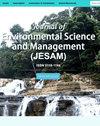菲律宾宿务岛破碎林中宿务黑沙马的遗传多样性和相对丰度
IF 0.3
4区 环境科学与生态学
Q4 ENVIRONMENTAL SCIENCES
引用次数: 1
摘要
本研究基于619bp的cytB基因,测定了菲律宾宿务岛部分森林片断中宿务黑沙马(Copsychus cebuensis Steere)的相对丰度及其遗传多样性。雾网被用来捕捉这些森林碎片中的鸟。在被捕获的鸟类被释放之前,从它们身上拔下四根轮廓羽毛,并在提取DNA之前用70%乙醇储存在试管中。在访问的领土上发现了59只黑沙玛(C.cebuensis)个体。据估计,至少有13只黑沙马栖息在一公顷的森林栖息地。线粒体基因分析首次表明,cebuensis从一个最初庞大而稳定的种群开始,经过最近的孤立或瓶颈事件导致的最近的扩张,进化历史很长,如高单倍型多样性(Hd)和核苷酸多样性(πn)所示,即Hd>0.50和πn>0.005,Tajima的D检验值不显著,傅和李的D*,以及傅的Fs统计。据推测,这一瓶颈事件是栖息地破碎化。此外,cebuensis的系统发育分析支持其单系性。本文章由计算机程序翻译,如有差异,请以英文原文为准。
Genetic Diversity and Relative Abundance of Cebu Black Shama (Copsychus cebuensis Steere) in Fragmented Forests of Cebu Island, Philippines
This study determined the relative abundance of Cebu black shama (Copsychus cebuensis Steere) in selected isolated forest fragments in Cebu Island, Philippines and their genetic diversity based on 619 bp cytB gene. Mist nets were used to capture the bird in these forest fragments. Four contour feathers were plucked from the body of the caught birds, before they were released, and were stored in tubes with 70% ethanol before DNA extraction. Fifty-nine black shama (C. cebuensis) individuals were encountered from the visited territories. At least 13 black shama individuals were estimated to inhabit one hectare of forest habitat. For the first time, analyses of mitochondrial genes revealed that C. cebuensis had a long evolutionary history from an initially large and stable population that went through recent expansion resulting from a recent isolating or bottleneck event as indicated by high haplotype diversity (Hd) and nucleotide diversity (πn), i.e. Hd>0.50 and πn>0.005, and non-significant values of Tajima’s D test, Fu and Li’s D*, and Fu’s Fs statistics. It is hypothesized that this bottleneck event was habitat fragmentation. Furthermore, phylogenetic analyses of C. cebuensis supported its monophyly.
求助全文
通过发布文献求助,成功后即可免费获取论文全文。
去求助
来源期刊

Journal of Environmental Science and Management
ENVIRONMENTAL SCIENCES-
CiteScore
0.90
自引率
0.00%
发文量
10
审稿时长
2 months
期刊介绍:
The Journal of Environmental Science and Management (JESAM) is an international scientific journal produced semi-annually by the University of the Philippines Los Baños (UPLB).
JESAM gives particular premium to manuscript submissions that employ integrated methods resulting to analyses that provide new insights in environmental science, particularly in the areas of:
environmental planning and management;
protected areas development, planning, and management;
community-based resources management;
environmental chemistry and toxicology;
environmental restoration;
social theory and environment; and
environmental security and management.
 求助内容:
求助内容: 应助结果提醒方式:
应助结果提醒方式:


